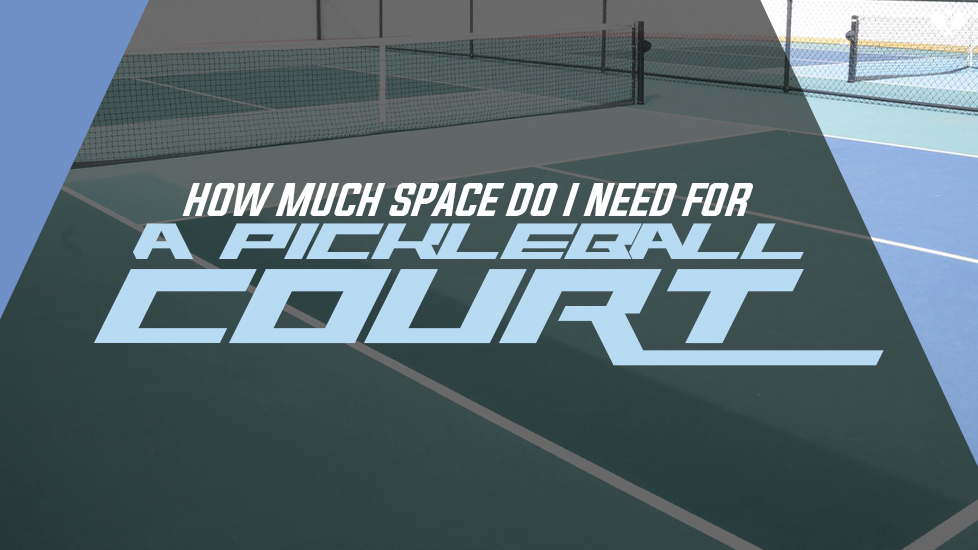The sport of pickleball has experienced an unprecedented surge in popularity in recent years, with an astounding 85% growth in the number of players between 2021 and 2022 in the United States alone. This remarkable rise indicates the sport’s universal appeal for people across all age groups and athletic prowess.
As the demand for pickleball courts continues to soar, the number of dedicated court sites nationwide steadily increases. A game that started as a recreational activity in a family’s backyard, pickleball is no longer confined to just recreational spaces; it’s played in backyards, community centers, and stadiums, reflecting its widespread adoption.
In response to this burgeoning interest, a natural question for new enthusiasts is: How big is a pickleball court? Today, we will discuss all things pickleball court. Please read below to learn more about how a pickleball court is constructed, its typical dimensions, and the culture surrounding this dynamic sport.
From backyard enthusiasts to professional players, everyone can benefit from the fundamental knowledge of pickleball court design to foster a thriving and inclusive community.
What Is the Size of A Pickleball Court?
Before delving into the dimensions and characteristics of a pickleball court, it’s crucial to grasp the overall size of this playing area. A standard pickleball court is designed with specific measurements to ensure fair and competitive gameplay.
A rectangular area 30 feet in width and 60 feet in height is at least required to build a court site. These dimensions ensure the court is built per the standard size of tournaments without huddling players into a confined space. Understanding these dimensions lays the foundation for exploring what makes a pickleball court a unique space for this rapidly growing sport.

What Are the Dimensions of A Pickleball Court?
A regular pickleball court measures 20 feet in width and 44 feet in length, adhering to standardized dimensions set by the USA Pickleball Association (USAPA). The court length is divided in two with the placement of a net. The teams stand on either side of the net. Other special zones are discussed below. But these precise measurements contribute to pickleball’s fast-paced and strategic nature, creating an environment where players can showcase their skills within defined boundaries.
What Does A Typical Pickleball Court Look Like?
A typical outdoor pickleball court surface is asphalt or concrete, ensuring a smooth and consistent bounce for the plastic ball. (An indoor pickleball court is similar except for an additional acrylic layer). The court is divided into halves by a net extending across the width. Each half comprises specific lines and zones, such as the baseline, sidelines, and kitchen.
Within each courtside, specific zones add layers of complexity to the sport. The non-volley zone (often called the “kitchen”) restricts players from making volleys (hitting the ball before it bounces) near the net. Combining these elements creates a visually engaging and strategically designed space where players can engage in challenges.
How To Build a Pickleball Court?
To begin building a pickleball court, the first step is to select an appropriate location. You must ensure that the area you’ve chosen is on level ground and doesn’t have obstructions for example, a tree in the middle. The next thing you want to do is prepping the surface. Deposit a consistent layer of asphalt or concrete to create a level playing field. Once you’ve done the leveling and given it time to dry, you can start marking the court layout using paint or tape according to the official dimensions.
Determine how many square feet is a pickleball court and mark the initial layout based on that. Marking the court site involves drawing boundaries (baselines along the width and sidelines along the length). A lateral halving of the court should be done to mark the net placement. The kitchen area would extend 7 meters on both sides of the net line. A centerline should divide the right and left, serving courts on each side of the net. Refer to the image below.

A typical pickleball court includes serving and non-volley zones on both sides of the net.
The net should be installed in the center of the court at 36 inches around the poles and 34 inches in the middle. Proper tensioning of the net is vital to maintain consistency during play.
The last step is optional and situational. You can add fencing around the court to establish concrete boundaries. It is also helpful to keep the court site secure from any obstructions from the outside world. Fencing not only adds a layer of safety but also contributes to the defined and organized appearance of the pickleball court.
If the court is functional after sunset, consider the lighting system of the court. Using efficient LED lights ensures excellent night visibility and helps preserve energy.
Building a pickleball court demands attention to detail and adherence to official specifications. It’s an ideal practice to follow the official USAPA guidelines to build a pickleball court from scratch. Practicing on a standard-sized court helps prepare you in the long run for professional tournaments.
Makeshift Pickleball Courts
A typical pickleball court has the exact dimensions of a badminton court. That is a severe size of land to be casually lying around for a pickleball court. Often, people create makeshift sites in their backyards to play pickleball. These courts are smaller than the standard pickleball courts, but they get the job they intend to do, i.e., provide quality entertainment for a family.
From transforming backyard spaces into personalized pickleball arenas to repurposing tennis courts for dual use, the passion of pickleball enthusiasts brings out the best of ingenuity amongst them. We’ll uncover below how people adapt existing spaces for spirited matches. Makeshift pickleball courts offer a glimpse into the resourcefulness that defines the ever-expanding community of pickleball players.
How Much Does It Cost to Build a Pickleball Court in Your Backyard?
To build a pickleball court in your backyard, you must consider various land, size, and budget factors. While the official dimensions of a pickleball court are 20 by 44 feet with a minimum land allotment of 30 by 60 feet, a backyard pickleball court need not follow these guidelines for amateur matches.
A few things that will affect the cost of your backyard courts are:
- The court leveling material, for example, concrete, is more expensive than asphalt.
- Whether the court will need fencing and lighting.
- The condition of the land, for example, does it have suitable drainage?
The initial expense involves clearing and prepping the land, including excavation and grading for a nearly flat surface. A very subtle slope will be prepared to allow for easy drainage. Then, the surface is prepared with asphalt or concrete.
The cost varies mainly because of your budget, the surface coat, the size, whether you’re DIYing or outsourcing, and additional facilities for the players. The average cost of leveling and grading per square foot of the court is between $10 and $25. Yet, depending on the above factors, a contractor can quote between $5000 to $50,000. The value would also differ from contractor to contractor for the same set of factors.
Pickleball Court on Tennis Courts
A more cost-effective way to play pickleball is a makeshift pickleball court on an old or functional tennis court. With millions of players in the United States, pickleball stands out as one of the fastest-growing sports, triggering a surge in demand for dedicated courts. Communities face the challenge of providing sufficient court space, often repurposing existing tennis courts to meet this demand. Converting tennis courts to makeshift pickleball courts caters to players of both sports and catches the court supply up to the demand.
A tennis court can be converted to a pickleball court in three ways. These are;
- A single pickleball court per tennis court
- Two pickleball courts per tennis court
- Four pickleball courts per tennis court
Each of these ways requires painting or taping over a tennis court. A tennis court (36 by 78 feet) is three times the size of a pickleball court, so it’s easy to use that space for several pickleball facilities.

However, many selected locations are underutilized tennis court sites and can be easily transformed into permanent pickleball courts. While both sports ideally prefer dedicated spaces, a wise approach involves creating multipurpose courts with lines for tennis and pickleball. This adaptation aims to balance the divergent needs of tennis and pickleball players within the limited space available.
For communities opting for a permanent court conversion, the entire tennis court surface is removed to install four dedicated pickleball courts. This approach is ideal for areas where pickleball surpasses tennis in popularity, ensuring efficient space utilization.
Alternatively, the multipurpose court conversion adds pickleball lines to existing tennis courts, accommodating the preferences of communities with solid tennis participation and a growing pickleball audience. While players may initially need to adapt to the additional lines, this solution provides a more flexible setup, allowing for two pickleball courts on one tennis court or even one pickleball court with portable nets.
Frequently Asked Questions
A pickleball court spans 20 feet wide, incorporating both in and out-of-bounds areas. This measurement aligns with standard regulations, ensuring consistency in gameplay across various venues and fostering a universal experience for players of all levels.
Measuring 44 feet in length, a pickleball court adheres to established standards. This length accommodates the court’s overall design, promoting fair play and strategic engagement while offering players ample space for maneuvering and executing diverse shots.
Pickleball courts thrive in diverse settings, including dedicated sports facilities, community centers, parks, and private clubs. The sport’s growing popularity contributes to the abundance of these courts, creating accessible spaces for players across ages and expertise to engage in the game.
Backyard pickleball courts typically mirror standard dimensions, providing a scaled-down version of the regulation court. While the official court dimensions state that a land of size of 30 by 60 feet is at least required for a pickleball facility, the scaled-down version can be 20 feet in width and 44 feet in height. These smaller courts cater to recreational play, allowing enthusiasts to enjoy the game in a more intimate and personalized setting within their residential space.
What Are The Dimensions Of A Pickleball Court: A Case Of Space Availability
Understanding how much space is needed to build a pickleball court is informative and insightful for players of all skill levels. With the sport experiencing an astounding 85% growth in players between 2021 and 2022, the demand for dedicated pickleball courts has never been higher.
The standard dimensions of a pickleball court, 20 by 44 feet, lay the foundation for a competitive and strategic playing space. The nuances of court construction should be studied in depth with the allocated budget to decide on the type of court that can be built in a facility.
As pickleball continues its remarkable ascent in popularity, the shared courts, whether purpose-built or adapted, serve as vibrant reminders of a fostering community, competition, and the joy of this rapidly growing sport.
Have you participated in a court project before? Share your thoughts below.


















